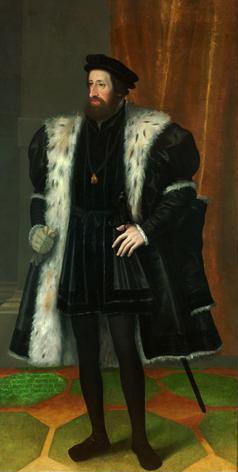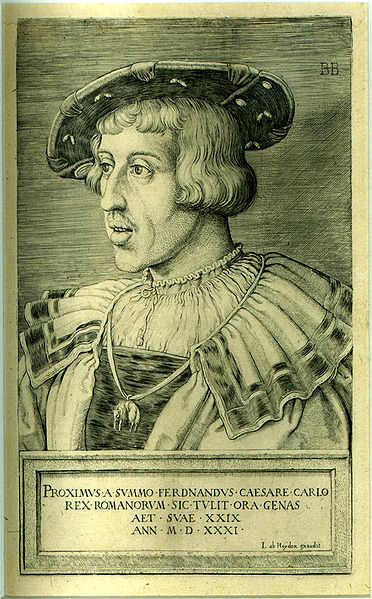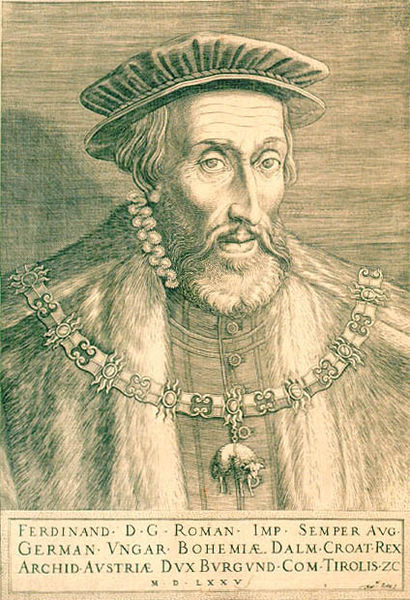<Back to Index>
- Mathematician John Playfair, 1748
- Painter Willem Roelofs, 1822
- Holy Roman Emperor Ferdinand I, 1503
PAGE SPONSOR



Ferdinand I (10 March 1503 – 25 July 1564) was a Central European monarch from the House of Habsburg. He was Holy Roman Emperor from 1558, king of Bohemia and Hungary from 1526, king of Croatia, Dalmatia, Slavonia, and formally king of Serbia, Galicia (in Eastern Europe), and Lodomeria, etc. He ruled the Austrian hereditary lands of the Habsburgs most of his public life, at the behest of his elder brother Charles V, Holy Roman Emperor and King of Spain. Ferdinand was Archduke of Austria from 1521 to 1564. After the death of his brother–in–law Louis II, Ferdinand ruled as King of Bohemia and Hungary (1526 – 1564). When Charles retired in 1556, Ferdinand became his de facto successor as Holy Roman Emperor, and de jure in 1558, while Spain, the Spanish Empire, Naples, Sicily, Milan, the Netherlands, and Franche-Comté went to Philip, son of Charles.
He was at the forefront in the defense of Central Europe against the Ottoman Empire,
whose great push into the area began in the 1520s. This fierce contest
occupied Ferdinand's energies for most of his life. Ferdinand's motto
was Fiat justitia et pereat mundus: "Let justice be done, though the world perish". Ferdinand was born in Alcalá de Henares, 40 km from Madrid, the son of the future Queen of Castile Infanta Joanna ("Joanna the Mad") and Habsburg Archduke Philip the Handsome, Duke of Burgundy and future King of Castile, who was heir to Emperor Maximilian I. Ferdinand shared his birthday with his maternal grandfather Ferdinand II of Aragon. Charles entrusted Ferdinand with the government of the Austrian hereditary lands, roughly modern-day Austria and Slovenia.
Ferdinand also served as his brother's deputy in the Holy Roman Empire
during his brother's many absences, and in 1531 was elected King of the Romans,
making him Charles's designated heir in the Empire. Charles abdicated
in 1556 and Ferdinand succeeded him, formally assuming the office in
1558. After Sultan Suleiman the Magnificent killed Ferdinand's brother-in-law Louis II, King of Bohemia and of Hungary at the battle of Mohács on 29 August 1526, Ferdinand was elected King of Bohemia in his place. The Croatian nobles at Cetin unanimously elected Ferdinand I as their king on 1 January 1527, and confirmed the succession to him and his heirs. In return for the throne Archduke Ferdinand at the Parliament on Cetin (Croatian: Cetinski Sabor)
promised to respect the historic rights, freedoms, laws and customs the
Croats had when united with the Hungarian kingdom and to defend Croatia from Ottoman invasion. In Hungary, Nicolaus Olahus, secretary of Louis, attached himself to the party of Ferdinand, but retained his position with the queen-dowager Mary of Habsburg. Ferdinand was elected King of Hungary by a rump diet in Pozsony in December 1526. The throne of Hungary became the subject of a dynastic dispute between Ferdinand and John Zápolya, voivode of Transylvania.
They were supported by different factions of the nobility in the
Hungarian kingdom; Ferdinand also had the support of his brother the
Emperor Charles V. After defeat by Ferdinand at the Battle of Tarcal in September 1527 and again in the Battle of Szina in March 1528, Zápolya gained the support of Suleiman the Magnificent,
the Ottoman Sultan. Ferdinand was able to win control only of western
Hungary because Zápolya clung to the east and the Ottomans to
the conquered south. Zápolya's widow, Isabella Jagiełło, ceded Royal Hungary and Transylvania to Ferdinand in the Treaty of Weissenburg of 1551. In 1554 Ogier Ghiselin de Busbecq was sent to Istanbul by Ferdinand to discuss a border treaty over disputed land with Suleiman. The
most dangerous moment of Ferdinand's career came in 1529 when he took
refuge in Bohemia from a massive but ultimately unsuccessful assault on
his capital by Suleiman and the Ottoman armies at the Siege of Vienna.
A further Ottoman attack on Vienna was repelled in 1533. In that year
Ferdinand signed a peace treaty with the Ottoman Empire, splitting
Hungary into a Habsburg sector in the west and John Zápolya's
domain in the east, the latter effectively a vassal state of the
Ottoman Empire. In 1538, by the Treaty of Nagyvárad, Ferdinand became Zápolya's successor. He was unable to enforce this agreement during his lifetime because John II Sigismund Zápolya,
infant son of John Zápolya and Isabella Jagiełło, was elected
King of Hungary in 1540. Zápolya was initially supported by King Sigismund of
Poland, his mother's father, but in 1543 a treaty was signed between
the Habsburgs and the Polish ruler as a result of which Poland became
neutral in the conflict. Prince Sigismund Augustus married Elisabeth of Austria, Ferdinand's daughter.
After decades of religious and political unrest in the German states, Charles V ordered a general Diet in Augsburg at
which the various states would discuss the religious problem and its
solution. Charles himself did not attend, and delegated authority to
his brother, Ferdinand, to "act and settle" disputes of territory,
religion and local power. At
the conference, Ferdinand cajoled, persuaded and threatened the various
representatives into agreement on three important principles. The
principle of cuius regio, eius religio provided
for internal religious unity within a state: The religion of the prince
became the religion of the state and all its inhabitants. Those
inhabitants who could not conform to the prince's religion were allowed
to leave, an innovative idea in the sixteenth century; this principle
was discussed at length by the various delegates, who finally reached
agreement on the specifics of its wording after examining the problem
and the proposed solution from every possible angle. The second
principle covered the special status of the ecclesiastical states,
called the ecclesiastical reservation, or reservatum ecclesiasticum.
If the prelate of an ecclesiastic state changed his religion, the men
and women living in that state did not have to do so. Instead, the
prelate was expected to resign from his post, although this was not
spelled out in the agreement. The third principle, known as Ferdinand's Declaration,
exempted knights and some of the cities from the requirement of
religious uniformity, if the reformed religion had been practiced there
since the mid 1520s, allowing for a few mixed cities and towns where
Catholics and Lutherans had lived together. It also protected the
authority of the princely families, the knights and some of the cities
to determine what religious uniformity meant in their territories.
Ferdinand inserted this at the last minute, on his own authority. After
1555, the Peace of Augsburg became the legitimating legal document
governing the co-existence of the Lutheran and Catholic faiths in the
German lands of the Holy Roman Empire, and it served to ameliorate many
of the tensions between followers of the so-called Old Faith and the
followers of Luther, but it had two fundamental flaws. First, Ferdinand
had rushed the article on ecclesiastical reservation through the debate; it had not undergone the scrutiny and discussion that attended the widespread acceptance and support of cuius regio, eius religio. Consequently, its wording did not cover all, or even most, potential legal scenarios. The Declaratio Ferdinandei was not debated in plenary session at all; using his authority to "act and settle," Ferdinand had added it at the last minute, responding to lobbying by princely families and knights. While
these specific failings came back to haunt the Empire in subsequent
decades, perhaps the greatest weakness of the Peace of Augsburg was its
failure to take into account the growing diversity of religious
expression emerging in the so-called evangelical and reformed traditions. Other confessions had acquired popular, if not legal,
legitimacy in the intervening decades and by 1555, the reforms proposed
by Luther were no longer the only possibilities of religious expression: Anabaptists, such as the Frisian Menno Simons (1492 – 1559) and his followers; the followers of John Calvin, who were particularly strong in the southwest and the northwest; and the followers of Huldrych Zwingli were
excluded from considerations and protections under the Peace of
Augsburg. According to the Augsburg agreement, their religious beliefs
remained heretical. In 1556, amid great pomp, and leaning on the shoulder of one of his favorites (the 24 year old William, Count of Nassau and Orange), Charles gave away his lands and his offices. The Spanish empire, which included Spain, the Netherlands, Naples, Milan and Spain's possessions in the Americas, went to his son, Philip.
His brother, Ferdinand, who had negotiated the treaty in the previous
year, was already in possession of the Austrian lands and was also to
succeed Charles as Holy Roman Emperor. This
course of events had been guaranteed already on January 5, 1531 when
Ferdinand had been elected the King of Romans and so the legitimate
successor of the reigning Emperor. Charles' choices were appropriate. Philip was culturally Spanish: he was born in Valladolid and
raised in the Spanish court, his native tongue was Spanish, and he
preferred to live in Spain. Ferdinand was familiar with, and to, the
other princes of the Holy Roman Empire. Although he too had been born
in Spain, he had administered his brother's affairs in the Empire since
1531. Some
historians maintain Ferdinand had also been touched by the reformed
philosophies, and was probably the closest the Holy Roman Empire ever
came to a Protestant emperor; he remained nominally a Catholic
throughout his life, although reportedly he refused last rites on his
deathbed. Other historians maintain he was as Catholic as his brother, but tended to see religion as outside the political sphere. Charles'
abdication had far-reaching consequences in imperial diplomatic
relations with France and the Netherlands, particularly in his
allotment of the Spanish kingdom to Philip. In France, the kings and
their ministers grew increasingly uneasy about Habsburg encirclement
and sought allies against Habsburg hegemony from among the border
German territories, and even from some of the Protestant kings. In the
Netherlands, Philip's ascension in Spain raised particular problems;
for the sake of harmony, order, and prosperity Charles had not blocked
the Reformation, and had tolerated a high level of local autonomy. An
ardent Catholic and rigidly autocratic prince, Philip pursued an
aggressive political, economic and religious policy toward the Dutch,
resulting in a Dutch rebellion shortly
after he became king. Philip's militant response meant the occupation
of much of the upper provinces by troops of, or hired by, Habsburg Spain and the constant ebb and flow of Spanish men and provisions on the so-called Spanish road from northern Italy, through the Burgundian lands, to and from Flanders. The
abdication did not automatically make Ferdinand the Holy Roman Emperor.
Charles abdicated as Emperor in January, 1556 in favor of his brother
Ferdinand; however, due to lengthy debate and bureaucratic procedure,
the Imperial Diet did
not accept the abdication (and thus make it legally valid) until May 3,
1558. Up to that date, Charles continued to use the title of Emperor. The western rump of Hungary over which Ferdinand retained dominion became known as Royal Hungary.
As the ruler of Austria, Bohemia and Royal Hungary, Ferdinand adopted a
policy of centralization and, in common with other monarchs of the
time, the construction of an absolute monarchy. In 1527, soon after ascending the throne, he published a constitution for his hereditary domains (Hofstaatsordnung) and established Austrian-style institutions in Pressburg for Hungary, in Prague for Bohemia, and in Breslau for Silesia.
Opposition from the nobles in those realms forced him to concede the
independence of these institutions from supervision by the Austrian
government in Vienna in 1559. After Ottoman invasion of Hungary the traditional Hungarian coronation city, Székesfehérvár fell
under Turkish occupation. Thus, in 1536 the Hungarian Diet decided than a
new place for coronation of the king as well as a meeting place for the
Diet itself would be set in Pressburg.
Ferdinand proposed that Hungarian and Bohemian diets should convene and
hold debates together with Austrian estates, but both their former
refused such an innovation. In 1547 the Bohemian Estates rebelled against Ferdinand after he had ordered the Bohemian army to move against the German Protestants. After suppressing Prague with the help of his brother Charles V's
Spanish forces, he retaliated by limiting the privileges of Bohemian
cities and inserting a new bureaucracy of royal officials to control
urban authorities. Ferdinand was a supporter of the Counter-Reformation and helped lead the Catholic response against what he saw as the heretical tide of Protestantism. For example, in 1551 he invited the Jesuits to Vienna and in 1556 to Prague. Finally, in 1561 Ferdinand revived the Archdiocese of Prague, which had been previously liquidated due to the success of the Protestants. Ferdinand died in Vienna and is buried in St. Vitus Cathedral in Prague.
On 25 May 1521 in Linz, Austria, Ferdinand married Anna of Bohemia and Hungary (1503 – 1547), daughter of Vladislaus II of Bohemia and Hungary and his wife Anne de Foix. They had fifteen children, all but two of whom reached adulthood.